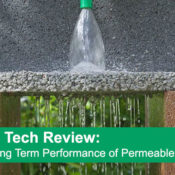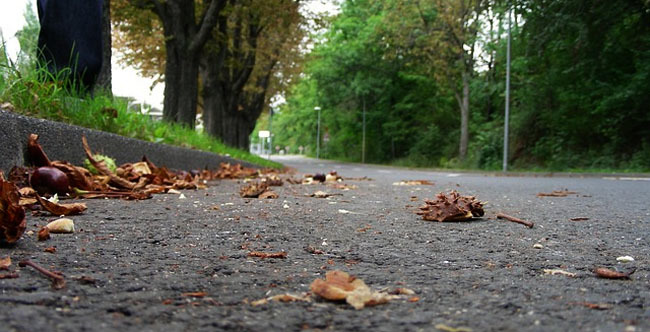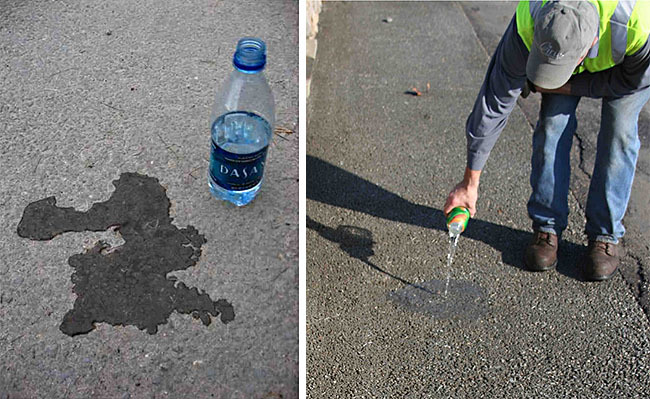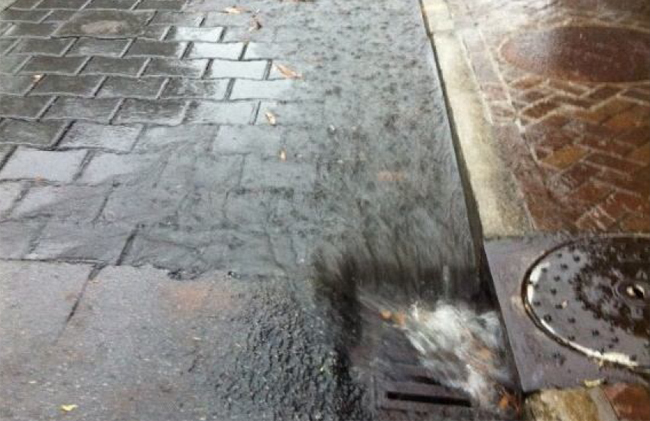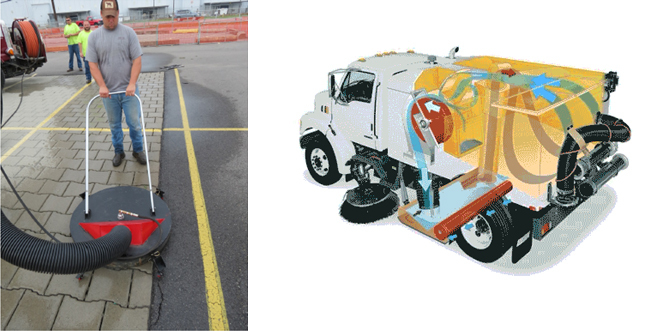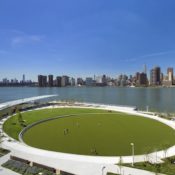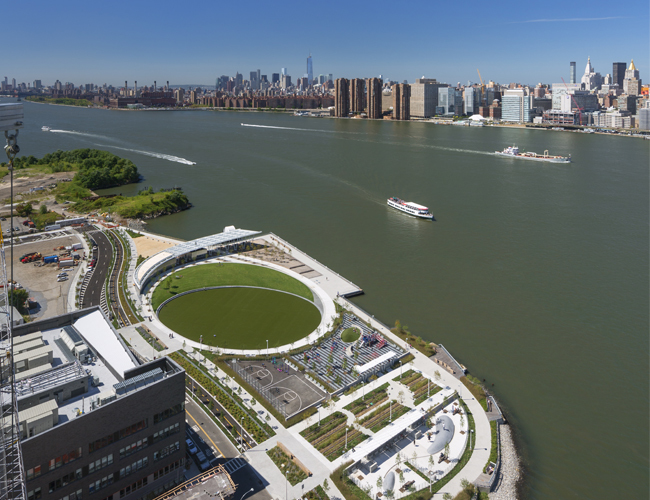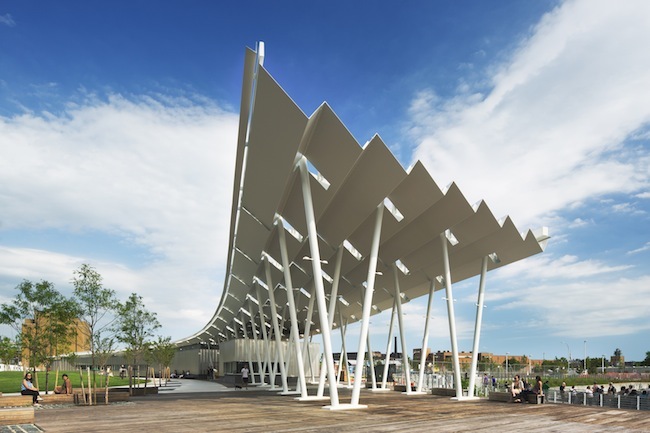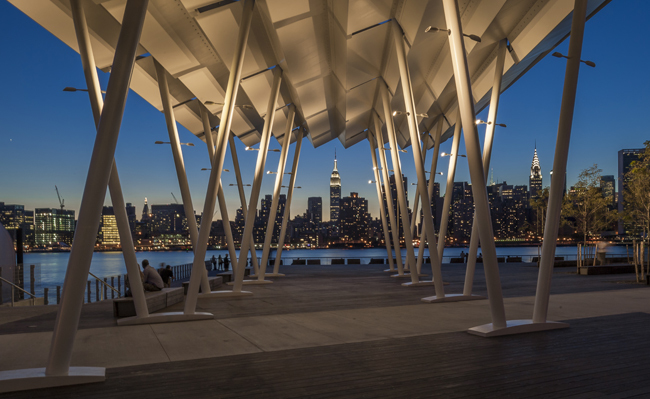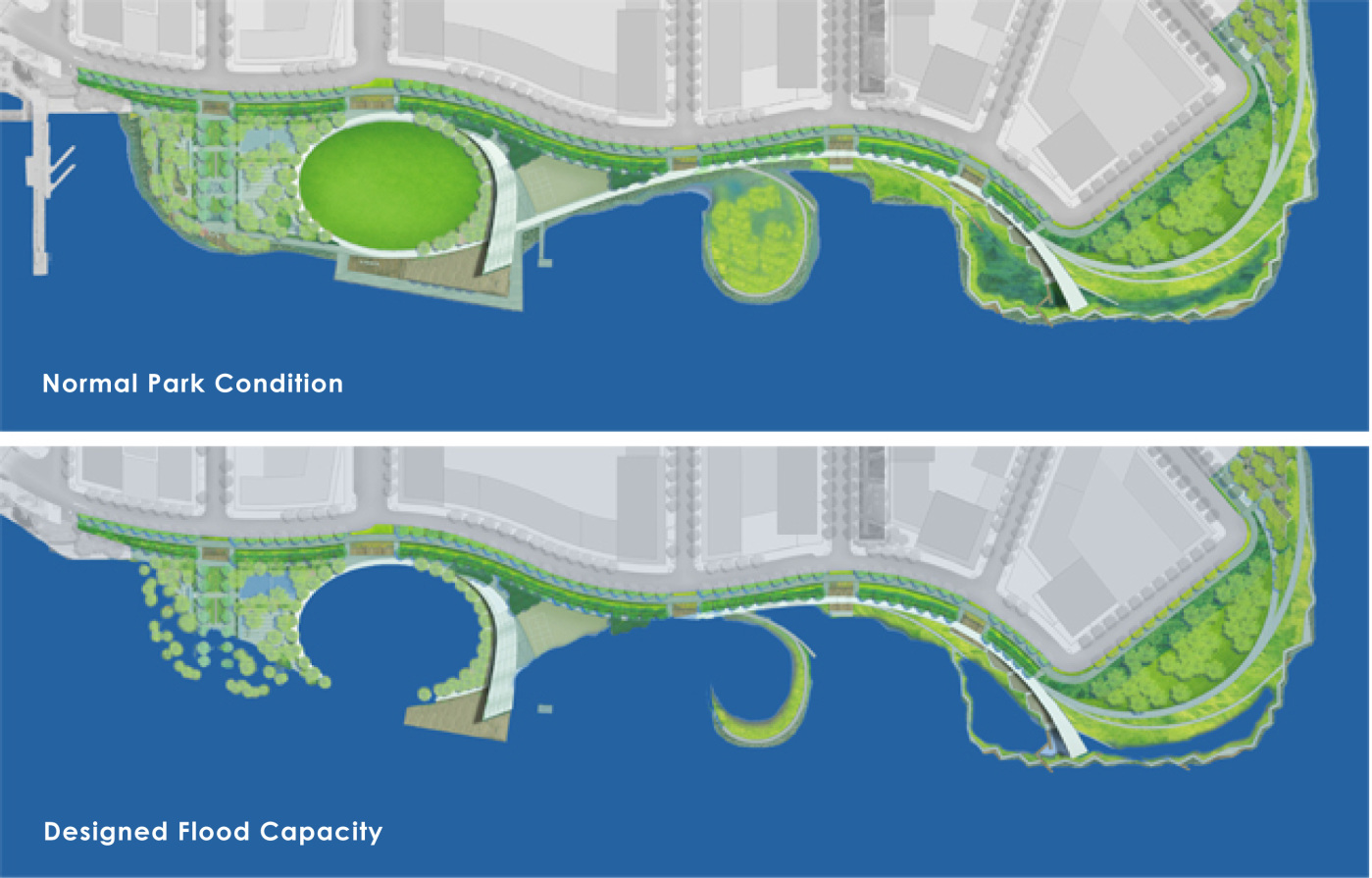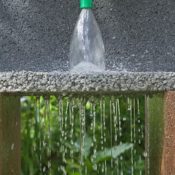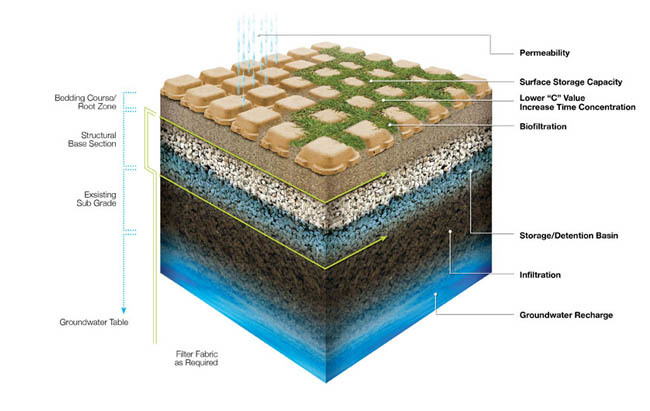Author: Nicholas Buesking
Green Tech Review: The Long Term Performance of Permeable Paving
Permeable pavements are a great tool for alleviating stormwater issues. Proper design—like with most landscape technologies—is key to their success. Yet as these installations age, they clog and no longer perform as designed. If infiltration cannot be restored through normal means, the pavement must be totally reconstructed. Does this issue mean that landscape architects been over-eager in using permeable pavement as a solution for stormwater management?
Debris like leaf litter can build up annually and reduce the infiltration rates of pervious paving. Image credit: BigBlockBobber, pixabay.com
Routine Maintenance
Landscape architects have long understood the need to maintain permeable pavements to sustain performance levels and have been talking about maintenance routines almost since they were first used. Surface clogging that occurs through leaf litter, mulch, soil, sand, and other debris can be prevented with a little client and laborer education and simple, routine maintenance. Typically, a simple vacuum cleaning once or more per year is adequate to prevent any significant performance decreases due to large debris. Even with basic maintenance, clogging does naturally occur as sediment is carried with stormwater into the porous surface.
This pervious concrete installation in Kennekee Beach, Maine, was clogged because it was designed in a depression and as a result quickly collected sand and other sediment. Restorative cleaning through vacuuming re-established infiltration. Image credit: Bruce Ferguson
Surface Infiltration
Permeable pavements are designed to have incredibly high baseline infiltration rates. The generally accepted industry standard is 100 inches/hr. Even a high intensity storm cannot produce nearly enough water to supersede these rates. Because of this, reduced infiltration rates initially are not an issue.
For example, let’s look at a hundred-year, one-hour rainstorm event in Chicago. This storm has an estimated rainfall depth of 3.04 inches. Even though micro-burst storms will have a greater intensity than a one-hour storm, a one-hour storm is a good indicator of infiltration capability. A rainfall event would have to exceed the hundred-year storm depth by 3290% for it to overwhelm the pavers’ capability. The surface infiltration rates can be reduced by a factor of nearly 30 before a high rainfall event would exceed its capability. A major caveat in this example is that it assumes the permeable pavement does not receive runoff from a larger catchment area. If it does, the rainfall depth effectively is multiplied by a factor of the area of total watershed to permeable surface. Nonetheless, at peak performance, it is far more likely that the sub-base detention will flood than the surface will fail to handle runoff.
This pavement was part of the study by the University of Louisville. In this case, the pavers are not clogged. Rather, the problem is that the sub-base is flooded. Image credit: Un. of Louisville Center for Infrastructure Research
Restorative Maintenance
Eventually, sediment does reduce infiltration rates to the point which the permeable surface does not function properly. Depending on site factors like traffic, winter care, and routine maintenance, restorative cleaning may be needed anywhere from as infrequently as once every twenty years to as frequently as once a year. In most cases, it will likely be needed once every few years. The best option is to have the infiltration tested once a year after the initial routine maintenance in the spring.
RELATED STORY: Green Tech Review: Utilizing Permeable Pavements Wisely in the Landscape
While many methods of restorative maintenance exist, using proven, effective methods is important. Sediment usually gets trapped in the first half inch to inch of jointing material. Some recommended methods can actually drive sediment layer deeper than that, permanently reducing infiltration rates. A white paper published by Elgin Sweeper Company showed that using a regenerative air sweeper on a regular basis and using a high power vacuum are among the more effective methods to restore infiltration rates. A recent study from the University of Louisville Center for Infrastructure Research also demonstrated that using a high powered vacuum head was consistently effective in restoring infiltration rates in permeable pavers. The study showed that a simple vacuum/sweeping machine is ineffective and that repeated treatments with power washers became gradually less effective, and additionally has the potential to drive sediment deeper into the aggregate or paving.
LEFT: A high power vacuum head by PaveDrain featured in the study by the University of St. Louis. Image credit: Un. of Louisville Center for Infrastructure Research. RIGHT: A cross-section of a regenerative air sweeper. Image credit: Elgin Sweeper Company
The graph shows the restoration of infiltration rates along several points in the test Pave-Drain pavement through different methods. The vac-head method was the only one proved to be consistently effective. Image credit: Un. of Louisville Center for Infrastructure Research
Material Choice
Maintenance aside, does choice of paving material affect long term performance? An interview Bruce Ferguson, FASLA—one of the leading experts in permeable pavement—shed some light on the topic.
Throughout the conversation, proper siting and design were continual themes. Overall, he held the long term success of permeable paving in a positive light. He asserted that with regular maintenance most permeable installations will not become so clogged as to necessitate total reconstruction. Throughout his experience, the only installations he has seen clogged beyond repair are porous concrete and asphalt. He explained that this can happen because the initial mix is poor, or with asphalt, the binding oil shifts over time and the pavement clogs itself.
For turf grid systems, Ferguson’s experience indicates that they work only where traffic is limited. With them, the grass is often still not as well protected as it needs to be, resulting in compacted soil and an un-vegetated surface. Although many of the leading pavement types are viable with proper design, permeable pavers seem to be the most reliable material in the permeable pavement market at this point in time.
All permeable pavements face issues with clogging to some degree, an inherit weakness caused in infiltrating water. With a proper maintenance schedule, however, most of the difficulties with long term performance can be eliminated. The paving material itself can also make a huge difference. Proper siting, design, and maintenance are needed for permeable paving to be an effective stormwater management tool, but the same caution should be taken with all performance-based design.
Thanks to Bruce Ferguson, Dan Salsinger, ICPI, and the University of Louisville Center for Infrastructure Research for their contribution of knowledge.
Hunter’s Point South Waterfront Park Serves as a Model of Urban Resiliency in Handling Floodwater
Across the East River from Manhattan, Hunter’s Point South Waterfront Park showcases impressive views of the iconic New York City skyline. In addition to the sweeping views, the park also successfully demonstrates strategies for resiliency and aesthetic appeal in a complex urban environment. Although the project just opened last year, its reputation as a leading model of urban resiliency has already stretched far beyond NYC.
Hunter’s Point South from the north. The elliptical lawn, with its flexible program, serves as the focus point of the park. Image credit: Albert Vecerka, Esto.
Designed by Thomas Balsley Associates, Weiss/Manfredi, and ARUP, the 11-acre waterfront park in Queens was created as part of a much larger Hunter’s Point South redevelopment of an old industrial sector. Once completed, the development will include 5,000 residential units, 100,000 square feet of commercial/public space, and a school. On its north end, the park connects to Gantry Plaza State Park, an iconic park in New York that highlights the industrial history of the site and projects a rugged blue-collar aesthetic. Since Balsley also designed Gantry Plaza State Park, certain aesthetic details were carried over but changed in tone. Where Gantry State Park relies on the datum relationship between bank and piers, the edge of Hunter’s Point South gently sweeps in and out, mimicking a natural shoreline.
Image credit: Weiss/Manfredi.
The park creates a compelling view of the Empire State Building from the pavilion structure. Image credit: Wade Zimmerman.
The park itself is split into two main halves: the active and the passive. Near the school, the north side provides active programming with basketball courts, a dog run, a playground, a sandy waterless beach, and a central elliptical lawn. This part of the park provides the essential draw for pedestrians, breathing life into the park. The other half plays a passive role, providing paths and overlooks for pedestrians to stroll, contemplate, and enjoy the views.
Image credit: Weiss/Manfredi.
Overall, the park has a natural but clean aesthetic that marries the site’s industrial history to its new urban context. Hunter’s Point South, however, addresses far more than the standard layers of urban design. During the conceptual development of the park, Thomas Balsley Associates and Weiss/Manfredi knew that they had an important chance to address issues of urban resiliency, so the park was built to handle storm surges and flooding. In heavily structured areas, the park is built to drain quickly while keeping certain areas above water. On the south side of the park, a marsh deals with flooding by using native species able to withstand periods of saltwater inundation. In combination with a rip rap edge, the roots of the plants also prevent erosion in what could be highly volatile land.
Image credit: Weiss/Manfredi.
Parts of the park are designed to become inundated in response to strong storm events. Image credit: Weiss/Manfredi.
The flood capacity concept is not new and has been successfully implemented in other places prone to flooding. Mill Race Park by Michael Van Valkenburgh Associates is one such example. However, Hunter’s Point South does show the changing attitudes toward resilience in the planning and design field as well as the general public. To top it off, the park’s design has already shown its merit. Before it even opened, the park flooded in 2012 during Hurricane Sandy. It drained as planned, and the project moved forward with little setback. Ultimately, Hunter’s Point South demonstrates how landscape design can successfully integrate the concepts of resiliency and sustainability with a park that is first and foremost designed for people.
Lead image credit: Weiss/Manfredi
Via LAM, Vol. 104., No. 2
Green Tech Review: Utilizing Permeable Pavements Wisely in the Landscape
The basic premise of permeable paving systems is simple: Let water drain through pavement instead of across it. It is a boon for designers who advocate environmental responsibility by reducing or eliminating runoff and increasing water quality. However, despite the concept’s seeming simplicity, careless design can create a number of issues that eventually lead to pavement failure.
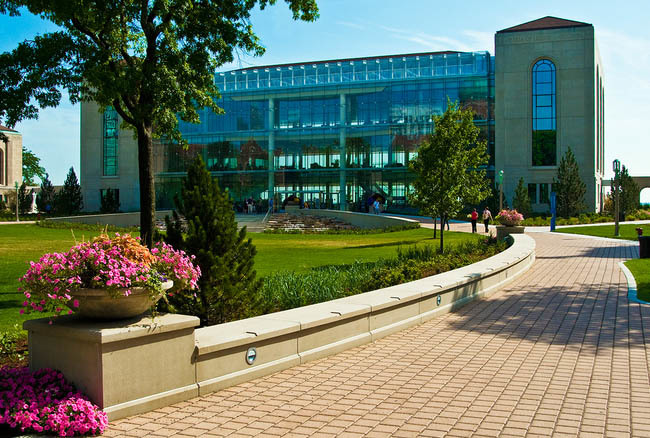
SmithGroupJJR’s design of the Loyola campus included a sweeping permeable paver walk.
As we, both as a society and a profession, look to “green” how we build, permeable paving has become a popular method of reducing stormwater runoff. There is a challenge, however, in utilizing it properly. Unlike permeable pavements, time-proven traditional engineering always tries to keep water out of the base. Why? Because water can be a powerful force in causing pavement to fail. As a result, we as designers must understand the influences of site conditions—like soil, climate, and rainfall—on the different components in order to ensure we can avoid the danger of introducing water into the base. Let’s take a look at a number of the key issues that might cause it to fail if designed improperly.
Intense Rainfall
Local rainfall patterns affect the necessary infiltration rates of the pavement. Some regions, like the Pacific Northwest, experience relatively low-intensity storm events. Here, choosing pavements with low infiltration rates can be acceptable. Different permeable pavements can provide anywhere from 10 in/hr to over 4000 in/hr of infiltration, but the standard acceptable baseline is 140 in/hr. If a rainfall event exceeds a pavement’s ability to infiltrate, the pavement floods and generates runoff. If, in fact, the goal is to achieve 100% infiltration, the heavier and more prolonged rain events a region receives, the deeper the sub-base needs to be for storage.
(Related Story: Philly Grad Creates Free Cloud-Based Stormwater Modeling Tool)
Poor Soils
Sandy soils are optimal for permeable paving. They drain quickly, reducing the likelihood water will be stored in the base. Often, even in regions with intense rainfall, the sub-base depth can be minimal. However, when permeable paving is sited on clay soils, the sub-base becomes highly important, since the sub-grade becomes easily saturated. Infiltrating water through the base brings up the issue of stability, especially in poor-draining soils. Water can cause the sub-grade and even the base to shift without proper containment. Geotextiles play a key role in the drainage capability and structural integrity of the pavement even though they are typically seen only as barrier to prevent clogging. The specified fabric can make or break the success of the pavement. Some do not allow any drainage, so the base remains permanently inundated—a pretty catastrophic situation! Others wick water horizontally, like a paper towel. These can keep water infiltrating when only one particular part of the sub-grade is inundated. Furthermore, since the sub-grade will frequently be wet, strong fabrics are essential because they can bridge soft spots in the sub-grade and lock the aggregate in place.
This illustration shows basic structural components of a concrete grid paving: paving, bedding, base, sub-base, and drainage fabric (with no underdrain).
(Related Thread: What’s Wrong with This Picture: Episode III – Revenge of the Site)
Cold Climates
Since water is designed to be stored in the sub-base of permeable pavements, frost heave is a serious issue when dealing with freezing temperatures. When combined with poor-draining soils, cold climates pose a very serious risk to their longevity. The key is to make sure water leaves the base as quickly as possible, which requires the use of an underdrain. Underdrains unfortunately lower true infiltration rates. However, without an underdrain, frost will almost certainly cause heaving.
In the end, it is imperative that we, as the designers, understand the complexity behind permeable pavement so that we can design appropriate, functional, and long lasting landscapes instead of simply marking off the sustainability checkbox.
Images via SmithGroupJJR (Photographer: Ken Cobb), Interlocking Concrete Pavement Institute, John Harrison, Soil Retention
Information via Dan Salsinger, Bruce Ferguson, the Center for Water and Watershed Studies, University of Washington and the EPA.
- 1
- 2


